Navy Quietly Fires 20 Hyper Velocity Projectiles Through Destroyer’s Deckgun
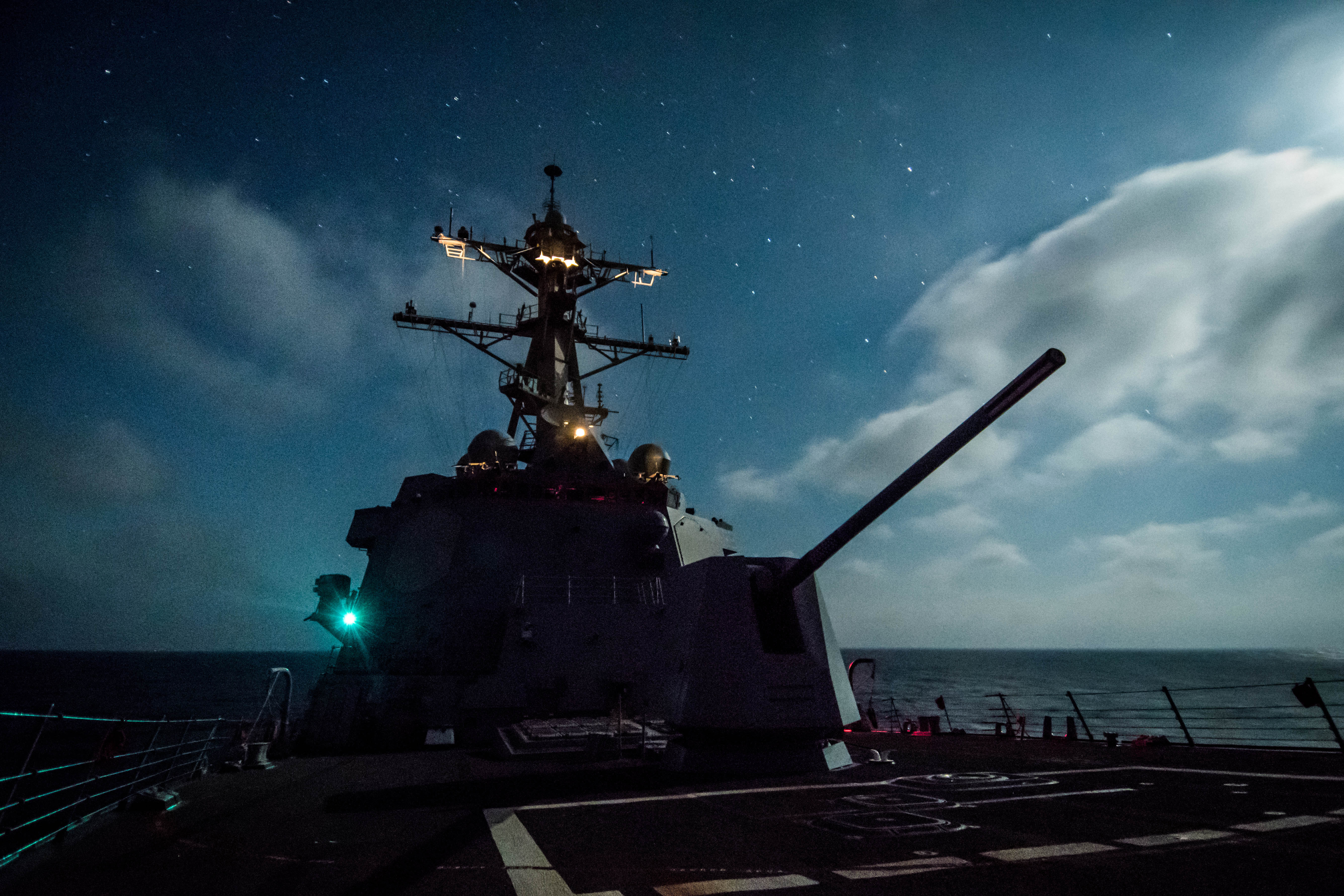
Guided-missile destroyer USS Dewey (DDG-105) transits the Pacific Ocean while underway in the U.S. 3rd Fleet area of operations. US Navy Photo
Last summer USS Dewey (DDG-105) fired 20 hyper velocity projectiles (HVP) from a standard Mk 45 5-inch deck gun in a quiet experiment that’s set to add new utility to the weapon found on almost every U.S. warship, officials familiar with the test have told USNI News.
The test, conducted by the Navy and the Pentagon’s Strategic Capabilities Office as part of the Rim of the Pacific (RIMPAC) 2018 international exercise, was part of a series of studies to prove the Navy could turn the more than 40-year-old deck gun design into an effective and low-cost weapon against cruise missiles and larger unmanned aerial vehicles.
While the HVP was originally designed to be the projectile for the electromagnetic railgun, the Navy and the Pentagon see the potential for a new missile defense weapon that can launch a guided round at near-hypersonic speeds.
Currently, the fleet uses a combination of missiles – like the Evolved Seasparrow Missile, the Rolling Airframe Missile and the Standard Missile 2 – to ward off cruise missile threats. The missiles are effective but also expensive, Bryan Clark with the Center for Strategic and Budgetary Assessments told USNI News on Monday.
In 2016, guided-missile destroyer USS Mason (DDG-87) fired three missiles to ward off two suspected Iranian cruise missiles fired from Houthi rebels in the Red Sea, in what amounted to a multi-million dollar engagement.
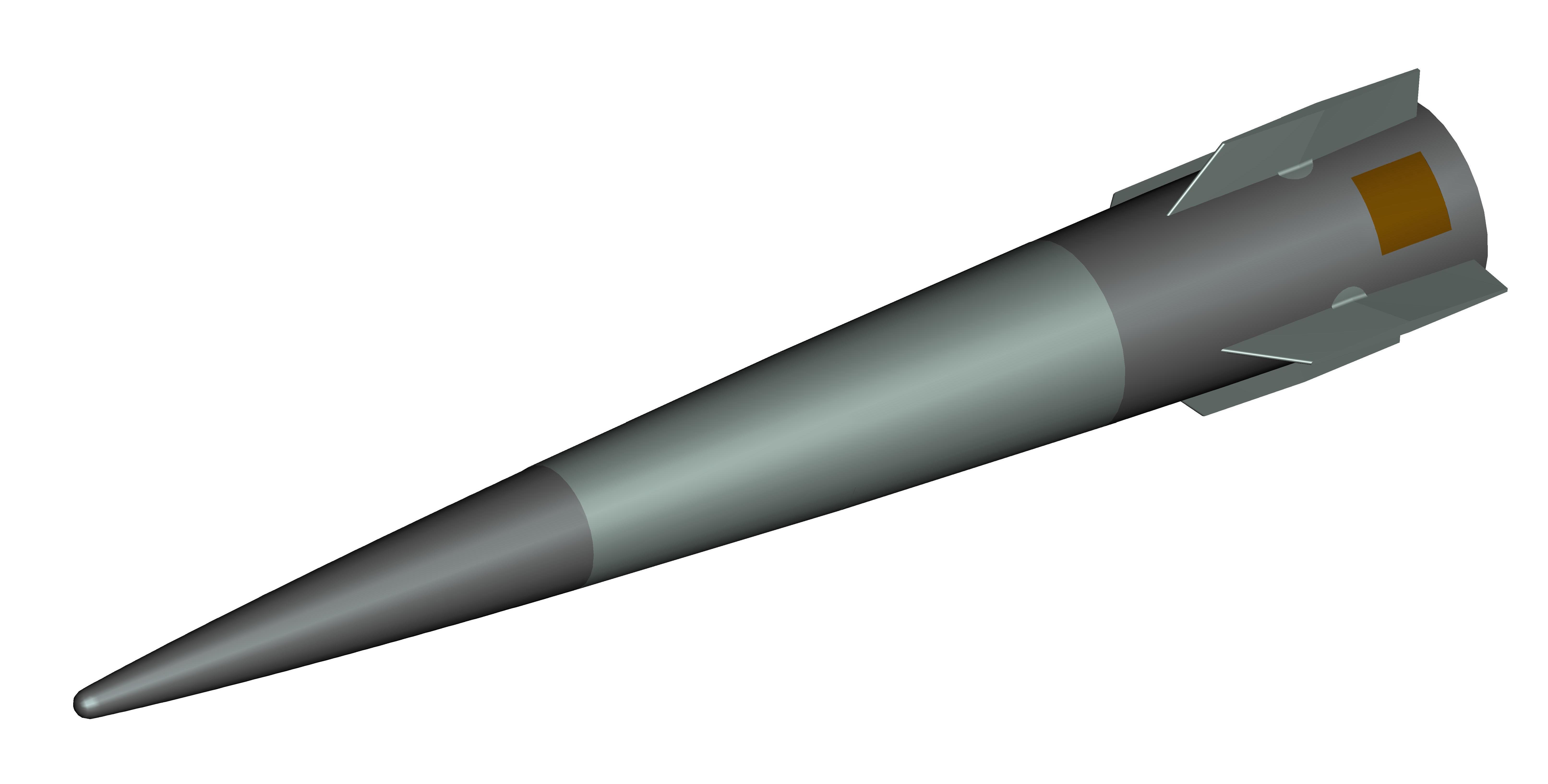
An artist’s conception of BAE Systems’ Hyper Velocity Projectile. BAE Systems Image
“So if you think about the kinds of threats you might face in the Middle East, the lower-end cruise missiles or a larger UAV, now you have a way to shoot them down that doesn’t require you use a $2 million ESSM or $1 million RAM because a hyper velocity projectile – even in the highest-end estimates have it in the $75,000 to $100,000 range, and that’s for the fanciest version of it with an onboard seeker,” he said.
An added benefit of using HVP in powder guns is the gun’s high rate of fire and a large magazine capacity.
“You can get 15 rounds a minute for an air defense mission as well as a surface-to-surface mission,” Clark said. “That adds significant missile defense capacity when you think that each of those might be replacing a ESSM or a RAM missile. They’re a lot less expensive.”
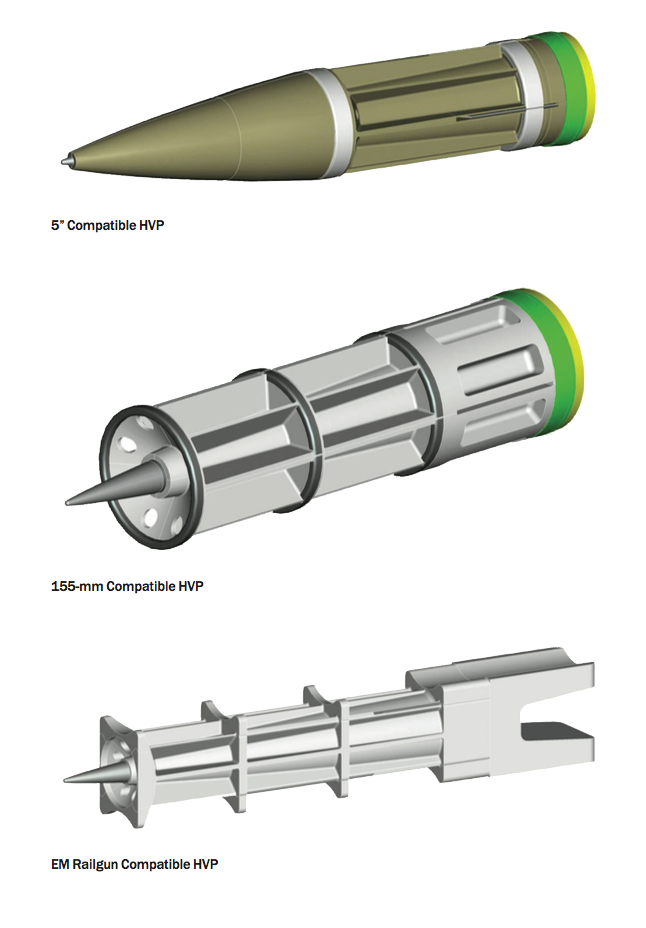
A range of hyper velocity projectiles from different weapon systems. BAE Systems Image
The HVP is also being investigated to use with ground-based 155mm artillery pieces for the Army and the Marines to provide limited air defense options for forward-deployed troops in austere environments. HVPs could also find a home aboard the Navy’s Zumwalt-class destroyers as a replacement round for the classes 155mm Advanced Gun System.
While officials confirmed to USNI News that the RIMPAC test was unclassified, both the Office of the Secretary of Defense and the Office of Naval Research would not acknowledge the test when asked by USNI News. A spokeswoman for OSD referred USNI News to the Navy.
“I don’t have anything for you,” an ONR spokesman told USNI News on Monday. HVP manufacturer BAE Systems referred USNI News to the Navy when contacted.
In 2016, William Roper, who then headed the SCO, said the promise of ONR’s HVP work had been recognized by the Navy and the Army and changed the way the Pentagon office thought about the evolution of the railgun.
“We now think that we can do pretty revolutionary things with existing powder guns – think howitzers, Paladins, the Navy’s five-inch guns. We’ve shifted emphasis to that,” Roper said during a 2016 talk at the Center for Strategic and International Studies.
“We have [more than] a 1,000 powder guns, we have very few railguns.”
https://news.usni.org/2019/01/08/navy-quietly-fires-20-hyper-velocity-projectiles-destroyers-deckgun
-------------------------------------------
The Drive 的报道:
U.S. Navy Destroyer Fired Off Advanced Hyper Velocity Projectiles During 2018 Exercise
The new rounds dramatically expand the ability of the guns on these ships and other platforms to engage surface targets and air and missile threats.
The U.S. Navy’s Arleigh Burke-class destroyer USS Dewey reportedly fired 20 Hyper Velocity Projectiles, or HVPs, from its main gun during the biennial Rim of the Pacific exercise, or RIMPAC, last year. It’s another major step forward for the program, which aims to give any Navy ship equipped with a five-inch deck gun, as well as other large caliber naval and land-based guns, a game-changing capability to conduct prompt strikes against various targets. It also holds the potential to give those same platforms a new way to shoot down helicopters, small drones, and even incoming anti-ship cruise missiles.
USNI News got the scoop on the previously unannounced tests, citing anonymous sources, but did not say specifically when the test firing had occurred or if the experiments had successfully fulfilled all of the test points. RIMPAC 2018, which occurred in the Pacific Ocean off the coast of the Hawaiian island of Kauai, ran from June 27 to Aug. 2, 2018.
RIMPAC 2018 included a number of live-fire drills, including the sinking of the retired Newport-class Landing Ship Tank the ex-USS Racine with a combination of air-, sea-, and ground-launched anti-ship cruise missiles and other weapons. We don’t know if Dewey fired any of its HVPs at the doomed ship.
Despite the test being unclassified, according to USNI News, the Navy has refused to confirm or deny it occurred at all. It is increasingly apparent that the service has something of a gag order, formal or not, on public discussions about the HVP, as well as its Electromagnetic Railgun (EMRG) program. Originally intended for the railgun specifically, the HVP, sometimes referred to now as the Gun Launched Guided Projectile (GLGP), has since evolved its own effort to develop a high-speed, multi-purpose projectile that will also work in traditional naval guns and land-based howitzers that use powder as a propellant. BAE Systems is the lead contractor on both projects.
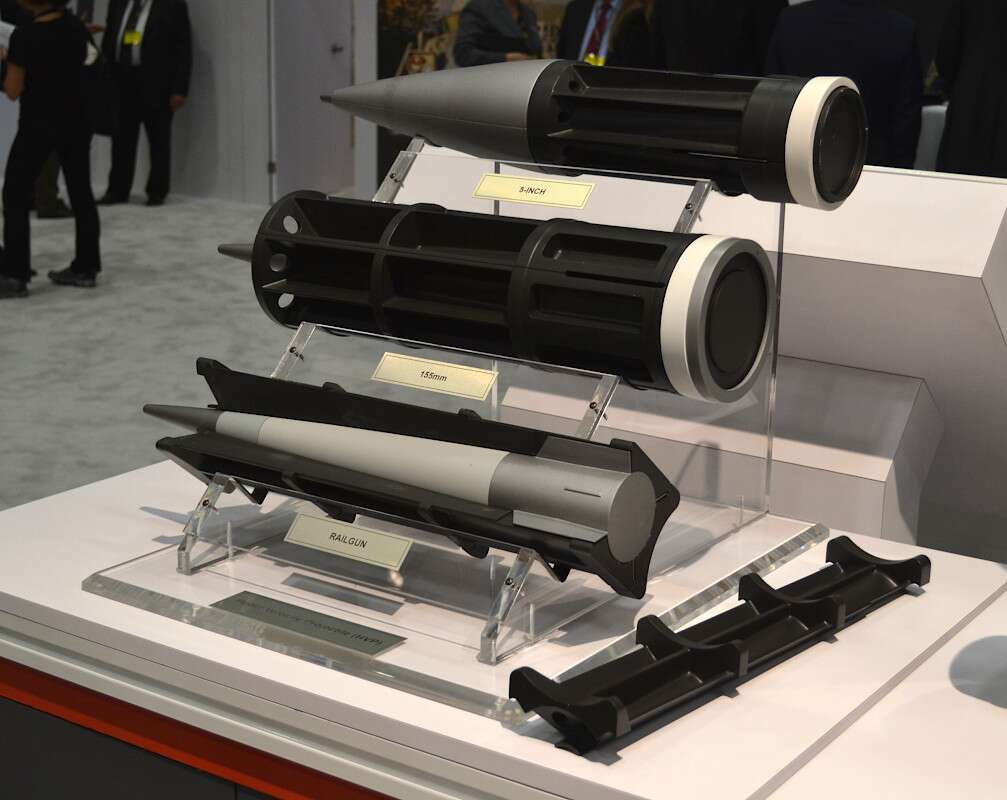
Mockups of the HVP for use in various different weapons. The five-inch type is at the top.
In January 2018, Vincent Sabio, the individual then in charge of the Hypervelocity Gun Weapon System (HGWS) program, an effort related to the HVP within the Pentagon’s secretive Strategic Capabilities Office (SCO), seemed to imply there would be a test involving the projectiles before the end of the year. “My program ends less than a year from now,” Sabio told a gathering at the Center for Strategic and International Studies think tank in Washington, D.C.
In 2016, SCO conducted separate tests of the HVP using unspecified conventional weapons, but it's not clear if those experiments occurred on land or at sea. SCO worked together with the Navy for the subsequent tests in the Pacific, according to USNI News.
Whatever the exact nature of the tests and their results, an at-sea demonstration of the HVP is still definitely a major milestone for the program. The new projectiles offer a relatively low-cost and low-risk capability boost for the Navy’s Arleigh Burke-class destroyers, Ticonderoga-class cruisers, and any other future ship that uses a variant of the Mk 45 five-inch gun.
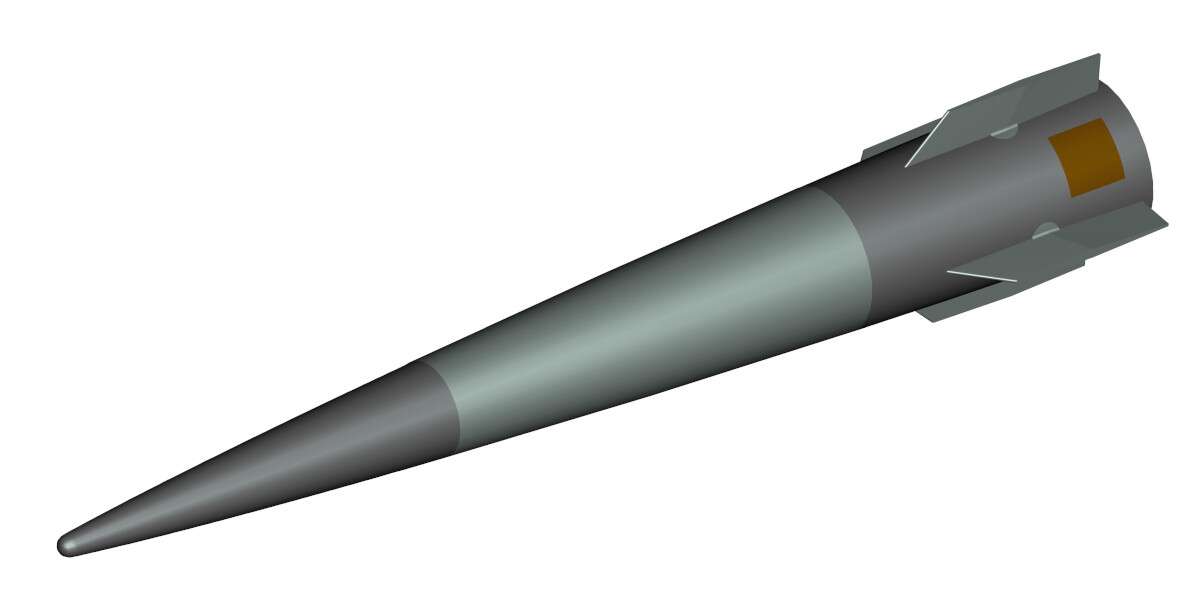
A three-dimensional rendering of the HVP.
The Navy wants to be able to shoot the HVPs at velocities up to Mach 3 from the Mk 45s using traditional propellant charges. This is half as fast as the service has been able to send the projectiles flying from its prototype railguns, but is still significantly faster than the speed of traditional five-inch shells.
With a maximum range close to 50 miles, the HVPs also dramatically outrange existing ammunition and can quickly cover that greater distance. This makes the rounds well suited to time-sensitive strikes against targets ashore. That speed and range would allow them to more quickly engage other warships and even fast-moving smaller watercraft, too. This would improve the Mk 45’s anti-surface warfare capabilities and give it a secondary close-in defense role against swarming boats.
The Navy hopes that the speed of the new projectiles will also give the Mk 45 much more robust anti-aircraft and all-new anti-missile capabilities, as well. At present, the service’s various warships rely on a mix of surface-to-air missiles and close-in defense systems to defend against those threats.

A graphic showing the various possible roles for HVP-armed ships, as well as those equipped with railguns.
The problem is that weapons such the Evolved Sea Sparrow Missile (ESSM) and the Standard Missile-2 (SM-2) are expensive per-shot especially for taking down small drones or incoming missiles. Close-in systems, including the Rolling Airframe Missile (RAM) and Phalanx Close-In Weapon System (CIWS), are true to their name and only provide a last line of defense against air and missile threats.
“That [hyper velocity] projectile has been independently costed – not by me, I wouldn’t expect you to believe my costing – but … by Navy IWS [Program Executive Office Integrated Warfare Systems] at about $85,000 a round,” SCO’s Sabio said in January 2018. “You can shoot a lot of those things and not feel badly about it.”
For comparison, each of the latest Block II ESSMs costs the Navy around $2 million, while individual RAMs set the service back around $640,000 apiece. The new gun-launched projectile’s $85,000 price tag is more than three times higher than the initial estimates, but is still exponentially cheaper than these missiles.
The Mk 45 also has the benefits of significant magazine depth and a relatively high rate of fire for a naval gun. Arleigh Burkes can carry around 600 shells for the guns, which can pump out shells at between 16 and 20 rounds per minute. This also means the gun could rapidly shoot multiple rounds to impact nearly simultaneously over a larger area.
The HVP’s cost could still grow in the future as the Navy continues to explore exactly what guidance options it might want to use to improve the projectile’s capabilities against different target sets and reduce its vulnerability to jamming, spoofing, and other countermeasures. Air and missile defense-focused subvariants would also need to be more maneuverable than surface strike types.
We don’t know the exact HVP configuration the Navy tested during RIMPAC 2018. But even at $100,000 per shell, it would still be a tenth of the price of a Rolling Airframe Missile and even cheaper than more advanced types.
The fast-flying projectile’s capabilities and price also make it attractive as an option for the Zumwalt-class stealth destroyer’s 155mm main guns. The weapons have been dead weight on those ships since the Navy canceled its plans to purchase the guided Long-Range Land Attack Projectile (LRLAP) after its price point grew to whopping $800,000 per shell.
If everything goes according to plan now, the HVP will work with Mk 45 guns, the 155mm guns on the Zumwalts, as well as 155mm howitzers on land and railguns the U.S. Army and Navy are testing separately. This will also help keep development and procurement costs low, since the main difference between the ammunition types will be the sabot that keeps the round steady as it travels down the barrel. At least from what we've seen so far, the projectiles themselves will be largely uniform no matter what weapon is firing them.
The Navy has not said when it expects the HVP to transition from a research and development effort into a fully-fledged procurement program or when its destroyers and cruisers might begin carrying the projectiles on actual operational patrols. But the testing at RIMPAC shows that the service is steadily pushing ahead to get this game-changing ammunition ready for action on its Arleigh Burkes and Ticonderogas, as well as other platforms at sea and on land.
Contact the author: jtrevithickpr@gmail.com